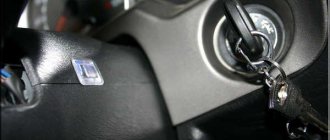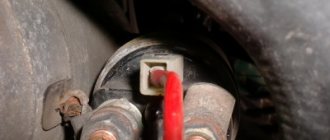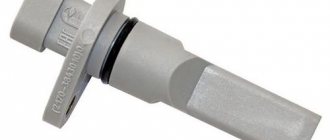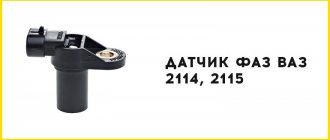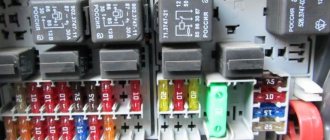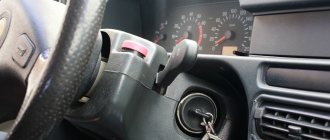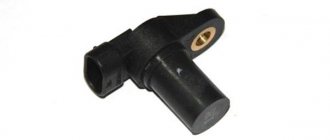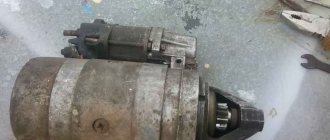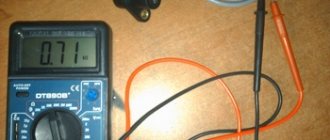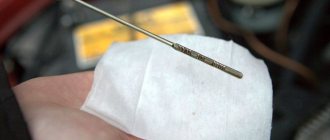Injection system
Nowadays, cars have become more advanced and technologically advanced. The control process from a carburetor engine switched to an injection engine. A car engine injector is much more reliable than a carburetor.
The injection system will allow you to more correctly control the car engine, which allows you to use fuel more economically. Modern cars are equipped only with injection engines, since using a carburetor engine is not advisable.
The injection system uses a large number of different sensors that send signals to the electronic engine control unit. Since the injection system uses a large number of sensors, they often fail. This is due to aging or improper operation of the car.
In this article we will talk about all the sensors installed on Lada cars, what role they play and what they are needed for.
Disabling the immobilizer on the Prior
Any vehicle, in addition to the main parts - engine, generator, wheel set, etc., includes several auxiliary systems that facilitate the operation of the machine. Immobilizers are among these elements that are not required for driving, but are very important. These devices provide security for a vehicle that has been tampered with. The immobilizer simply blocks the engine part of the car, preventing criminals from stealing it.
Despite the fact that the quality of products of the domestic automobile industry has increased several times in recent years, cars produced in Russia still have a large number of faults. Among these “childhood diseases” are problems with the immobilizer on the Prior. The standard anti-theft system often fails: the indicator lights up, the ignition is blocked and the fuel supply is cut off. As a result of errors, the vehicle simply refuses to start. If you are faced with a similar situation, read our article: it tells you how to disable the immobilizer on a Priora.
Mass air flow sensor
The mass air flow sensor, also known as mass air flow sensor, is installed on all fuel-injected Lada and VAZ cars. The sensor is located between the intake receiver bellows and the air filter box. This sensor is involved in the process of forming the fuel-air mixture. It also estimates the amount of intake air, taking into account its temperature. If there is a malfunction, the “CheckEngine” light does not always light up.
Signs of sensor malfunction:
- Loss of vehicle dynamics;
- Unstable idle;
- Jerking when moving;
- Difficulty starting the engine;
- High fuel consumption;
What to do if there are signs of a flow meter malfunction
First of all, carry out an inspection. To do this, you need to disconnect the negative terminal of the battery, disconnect the connector of the cable going from the mass air flow sensor to the computer, and carefully remove the flow meter. On Priora it is located near the air filter housing, after which the intake manifold air duct begins. For dismantling, you will need a Phillips screwdriver (loosen the clamp of the air duct pipe) and a size 8 wrench (bolts attaching to the filter).
There should be no cracks or dents on the case, the connector contacts should not be oxidized. Dust, and possibly water or oil stains, will most likely be found inside the MAF channel. This is the main reason for the massive failure of sensors: under normal operating conditions, mass air flow sensors live a long time and do not cause problems for car owners.
A dirty sensor must be blown off dust using an intense stream of air, then carefully washed with a special product or alcohol. Washing is done with an aerosol jet (when using the product) or pressure from a syringe (with alcohol). While the device is drying, be sure to wipe off dust from the air ducts and the filter housing inside. It is recommended to combine this procedure with replacing the air filter.
Speed sensor
The speed sensor is installed on the gearbox housing and is designed to measure the speed of the vehicle and calculate the kilometers traveled. The speed sensor also provides readings for preparing the air-fuel mixture while the car is moving. You can notice that when the car is rolling at neutral speed, the idle speed is slightly higher than when the car is stationary. When there is a malfunction, the “CheckEngine” light almost always comes on.
Signs of sensor malfunction:
- There are no increased speeds when driving at neutral speed;
- Speedometer does not show speed;
- The odometer does not work;
- EUR does not work;
Coolant temperature sensor
Coolant temperature sensor, also known as DTOZH. Installed in the thermostat housing. Serves to prepare the air-fuel mixture when starting the engine. It also simultaneously displays coolant temperature readings on the car’s dashboard and turns on the engine cooling fan. If there is a malfunction, the “CheckEngine” light does not light up.
Signs of sensor malfunction:
- Loss of vehicle dynamics;
- Unstable idle;
- Jerking when moving;
- Difficulty starting the engine;
- High fuel consumption;
- Difficulty starting in the cold season;
Actual fuel consumption of a Lada Priora with a 16-valve engine and various gearboxes
An experienced owner of any car probably knows that achieving ideal fuel consumption indicators is practically impossible. Thus, in winter and in urban conditions this figure shows a particular tendency to increase. In the warm season and on suburban highways, fuel consumption can decrease even below the declared level.
You can summarize the real indicators of mixed fuel consumption on three modifications of the Lada Priora with 16 valves as follows (in terms of “per hundred”):
- winter/city – 12-14 l;
- summer/city – 9-11 l;
- winter/road – 8-9 l;
- summer/track – 5.5-6.5 l
First of all, the possibility of achieving a low consumption of high-octane composition is determined by the 100% serviceability of all vehicle systems. However, correct driving techniques are no less relevant:
- maintain tire pressure of about 2.0 atm;
- drive with the windows closed and without a roof rack;
- adhere to a moderate pace of movement, without sudden acceleration and braking (on the highway - 80-90 km/h);
- apply engine braking;
- warm up a cold engine on the road;
- fill only with 95-grade gasoline;
- drive with the climate control switched off.
Crankshaft position sensor
Crankshaft position sensor, also known as DPKV. Installed on a bracket near the generator belt drive pulley. Works on the law of electromagnetic induction. Reads readings from the crown of the generator drive pulley. Sets the ignition timing angle (IAF). If there is a malfunction, the “CheckEngine” light comes on.
Signs of malfunction:
- The engine runs intermittently;
- The engine does not start (no spark);
conclusions
All the described methods can be done with your own hands even by inexperienced car enthusiasts. However, it is undoubtedly more convenient to obtain complete information about the status of devices and speed up this process using an auto scanner.
It is necessary to accurately distinguish between incorrect operation of the computer and a malfunction of one of the sensors. It is also worth considering other reasons for overconsumption, for example, a running air conditioner will increase fuel consumption by a full 10%. Timely repair of the breakdown allows you to avoid unexpected costs for the purchase of gasoline.
I decided to re-create the topic with all the nuances that might be worth paying attention to. The day before yesterday we replaced the alternator belt, bearing, pump, fuel filter, spark plugs, engine oil pump and engine oil. The spark plugs were ngk, I changed them to cheap Boshev ones for 250 rubles. I already pumped out 9 liters of gasoline and drove 60-65 km. That is, the consumption turns out to be 7 km per 1 liter, which is abnormal, with a calm driving style. I changed the speed control because when braking to stop, I pressed the clutch and threw it into neutral and the speed stayed at 1000-1100, and when idle, if I pressed the clutch they rose to this mark (Replacing the sensor did not help), the check light does not light up. During repairs, the terminal was removed accordingly. One innovation worries me: when starting from a stop, even at 1100-1200 rpm, the panel shows an instantaneous consumption of 19.9, if you drive 20 km/h (for example), then after a couple of seconds the instantaneous consumption drops by several liters, to 13-15. Previously, the situation was the opposite: with a quiet start, the instantaneous consumption was small and only if you gave 40 km/h in first gear did the consumption reach a maximum of 19.9. The instantaneous consumption has increased, and the average consumption has increased accordingly. I noticed that even at 60 km/h in 3/4 gear, give the gas to full throttle, the consumption instantly becomes 19.9, which was also not observed before. Now the indicators of the Open Diag program With the ignition on at an engine temperature of 88-92: Mass flow sensor voltage 1.016 (very rarely for a split second will jump to 1.021) TPS voltage 0.591 With the engine running at idle at engine temperature 88-92: Flow rate 1 l/hour +-0.1 Throttle valve opening angle - 0% TPS voltage 0.591 Desired engine speed 850 Engine speed 880-900 Desired mass air flow 7.9 kg/hour Mass air flow 8.2-8.4 (which I consider normal, because this was the case a year ago) Injection duration 3.8-3.9 Injection duration coefficient ranges from 0.98 to 1.01, which I also consider normal Ignition timing 3.8
By the way, after replacing the above, it didn’t become faster/slower, I stopped supporting the ass in 2nd gear. Now, dear car enthusiasts, with comprehensive data, who can tell me what? I’m thinking of throwing off the DMRV plug tomorrow and unscrewing the DPDZ and installing it, or just a terminal - because I think that after 60 km the brains would already be able to adapt. Of course, the figure is 11.5-12l in the city, when previously it was 8.5-9l the check is not lit.
Phase sensor
The phase sensor is installed on an engine with 16 valves, located near the fuel rail. Based on the law of electromagnetic induction, it takes readings from the intake camshaft master pulley. Participates in the process of formation of the air-fuel mixture for each cylinder separately. In the event of a malfunction, the engine begins to operate in emergency mode. When there is a malfunction, the “CheckEngine” light almost always comes on.
Signs of malfunction:
- The engine runs intermittently;
- Increased fuel consumption;
- Unstable engine operation at idle;
Total
The factory fuel consumption figure for Priora with 16-valve engines is 6.6-6.9 liters per mixed “hundred”. In reality, the appetite ranges from 8 to 14 liters. in winter and 5.5-11 l. in summer.
Increased fuel consumption can be caused by malfunctions in the fuel system, in the ECM, a clogged air filter, a clogged catalyst, incorrect operation of the air purge valve, or air leaks. Tire pressure and driving style also determine energy consumption.
Sooner or later, the euphoria from the new car wears off, and the owner begins to pay more and more attention to the fuel level needle, comparing the manufacturer’s stated figures with the real state of affairs. The dependence of these values on tire pressure or problems with the ignition system is clear even to novice motorists. But this is not always the root cause of excessive fuel consumption; sometimes the sources of the problem have to be looked deeper.
Idle speed control
The idle speed regulator, also known as IAC, is installed in the throttle valve. Designed to regulate idle speed on engines without the E-GAS system. The sensor is quite unreliable and fails very often. It is a motor with a worm gear. If there is a malfunction, the “CheckEngine” light does not light up.
Signs of malfunction:
- Not smooth idle;
- The revolutions are floating;
- Troubles the engine;
Throttle Position Sensor
The throttle position sensor (TPS) is installed on the throttle valve on cars without the E-GAZ system. Designed to regulate engine speed. The sensor is not reliable and often fails. If there is a malfunction, the “CheckEngine” light does not always light up.
Signs of malfunction:
- Not smooth idle;
- The revolutions are floating;
- Troubles the engine;
- When starting the engine, the speed is increased;
- Spontaneous increase or decrease in speed;
Oil pressure sensor
The oil pressure sensor is installed in the cylinder head. Designed to indicate oil pressure and indicate oil pressure when the engine is running. A very reliable sensor that rarely fails. The “CheckEngine” light does not light up when there is a malfunction.
Signs of malfunction:
- The oil pressure light is constantly on;
- The oil pressure light does not light up when the ignition is turned on;
Priora relay and fuse blocks
Location of relays and fuses in the DELRHI 15493150 mounting block
Location of relays and fuses in the mounting block 1118-3722010-00
Lada Priora relay - purpose
K1 Relay for turning on low beam and side lights of headlights (automatic lighting control system) K2 Relay for turning on heated rear window K3 Relay for turning on starter K4 Additional relay K5 K6 Relay for turning on high speed (automatic mode) windshield wiper K7 Relay for turning on high beam headlights K8 Relay for turning on sound signal K9 Relay for turning on the sound alarm signal K10 relay for turning on the fog lights K11 relay for turning on the electric heating of the front seats of the headlights
Lada Priora fuses - purpose
F1
Reserve
F2 (25 A)
Mounting block, relay for turning on the heated rear window (contacts) Electrical package controller, contact “10” of the XP2 block Rear window heating element
F3 (10 A)
Right headlight, high beam lamp Instrument cluster, high beam headlight indicator
F4 (10 A)
Left headlight, high beam lamp
F5 (10 A)
Mounting block, horn relay Horn
F6 (7.5 A)
Left headlight, low beam lamp
F7 (7.5 A)
Right headlight, low beam lamp
F8 (10 A)
Mounting block, alarm horn relay Sound alarm signal
F9
Reserve
F10 (10 A)
Instrument cluster, pin “20” Brake light switch Brake light lamps Interior lighting unit Interior lighting lamp Threshold lamp, right front doors Additional brake light
F11 (20 A)
Mounting block, windshield wiper high speed relay Wiper and washer switch, terminal “53a” Wiper and washer switch, terminal “53ah” Rear window heated switch Mounting block, rear window heated relay ( winding) Windshield wiper motor Rear window wiper motor (2171, 2172) Windshield washer motor Rear window washer motor (2171, 2172) Airbag control unit, pin “25”
F12 (10 A)
Instrument cluster, pin “21” Electrical accessories controller, contact “9” of the block X2 Electromechanical power steering control unit, contact “1” of the block X2 Reversing light switch Reversing light bulbs Parking system control unit, contacts “11” and “14”
F13 (15 A)
Cigarette lighter
F14 (5 A)
Side light lamps (left side) Instrument cluster, main light switch indicator License plate lights Trunk light Electrical package controller, pin “12” of block X2
F15 (5 A)
Side light lamps (right side) Storage lamp box
F16 (10 A)
Hydraulic unit, contact “18”
F17 (10 A)
Left fog light
F18 (10 A)
Right fog light
F19 (15 A)
Seat heating switch, contact “1” Front seat heaters
F20 (10 A)
Switch recirculation (switch on) Mounting block, relay for low beam headlights and parking lights (automatic lighting control system) Heater electric fan relay Automatic lighting control switch Windshield wiper and external lighting control unit, contacts “3”, “11” Automatic climate control system controller , pin “1” Automatic windshield wiper sensor (rain sensor), pin “1”
F21 (5 A)
Light switch, pin “30” Diagnostic deck, pin “16” Clock Automatic climate control system controller, pin “14” "
F22 (20 A)
Windshield wiper motor (automatic mode) Mounting block, windshield wiper relay and high speed windshield wiper relay, (contacts)
F23 (7.5 A)
Wiper and exterior lighting control unit, contact " 20”
F24-F30
Reserve
F31 (30 A)
Electrical package controller, terminal “2” of the block X1 Electrical package controller, terminal “3” of the block X1 Driver’s door module, pin “6” Threshold light of the left front door
Reserve F32
Oxygen sensor
The oxygen sensor is installed in the exhaust manifold of the car. Serves to monitor exhaust gases and adjust the air-fuel mixture. A reliable sensor rarely fails. If there is a malfunction, the “CheckEngine” light does not always light up.
Signs of sensor malfunction:
- Loss of vehicle dynamics;
- Unstable idle;
- Jerking when moving;
- Difficulty starting the engine;
- High fuel consumption;
- Black smoke when driving at high speeds;
Knock sensor
The knock sensor is installed on the cylinder block under the intake receiver. Based on the principle of the piezo element. Engine detonation is measured and the air-fuel mixture is adjusted. Quite a reliable sensor. If there is a malfunction, “CheckEngine” does not light up.
Signs of sensor malfunction:
- Loss of vehicle dynamics;
- Unstable idle;
- Jerking when moving;
Air conditioner sensor
The air conditioning sensor is installed under the bumper next to the air temperature sensor. Designed to turn on the air conditioner or protect against turning on at low temperatures. Let us remind you that the air conditioning in Lada cars only works at outside air temperatures of +5 degrees. Reliable sensor, no breakdowns were detected.
Signs of malfunction:
- The air conditioner clutch does not engage;
Mechanical engineering keeps up with the times, so new sensors appear quite quickly in car engine control.
Product delivery options
Note! Below are the shipping methods available specifically for this product. Payment options may vary depending on the shipping method. Detailed information can be found on the “Delivery and Payment” page.
Parcel by Russian Post
Available payment methods:
- Cash on delivery (payment upon receipt)
- Using cards Sberbank, VTB, Post Bank, Tinkoff
- Yandex money
- QIWI
- ROBOKASSA
Shipping throughout Russia. Delivery time is from 5 to 12 days.
Parcel by Russian Post 1st class
Available payment methods:
- Cash on delivery (payment upon receipt)
- Using cards Sberbank, VTB, Post Bank, Tinkoff
- Yandex money
- QIWI
- ROBOKASSA
Shipping throughout Russia. Delivery time is from 2 to 5 days. More expensive than regular delivery by Russian Post, approximately 50%. Parcel weight up to 2.5 kg
Express Parcel EMS
Available payment methods:
- Cash on delivery (payment upon receipt)
- Using cards Sberbank, VTB, Post Bank, Tinkoff
- Yandex money
- QIWI
- ROBOKASSA
Shipping throughout Russia. Delivery time is from 3 to 7 days. More expensive than regular delivery by Russian Post, approximately 100%.
Transport companies
Available payment methods:
- Using cards Sberbank, VTB, Post Bank, Tinkoff
- Yandex money
- QIWI
- ROBOKASSA
Delivery is possible to any locality where there is a representative office of the transport company. Delivery time is from 2 to 10 days. Sending large parcels is approximately 50% more profitable than by Russian Post.
Pickup from our warehouse
Available payment methods:
- Cash upon receipt
- Credit, installments
- Using cards Sberbank, VTB, Post Bank, Tinkoff
- Yandex money
- QIWI
- ROBOKASSA
Pickup times must coincide with store opening hours.
We’ll tell you a little secret, just don’t tell anyone else about it so as not to make people sad. All Lada cars are equipped with decorative plastic engine covers from the factory. But where they go on the way from the factory to the final buyer is the question. Buyers of Lada cars still have to deal with such relics of the past.
